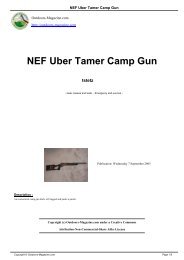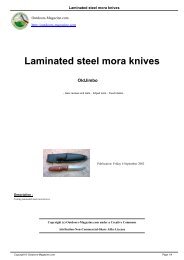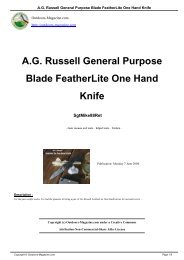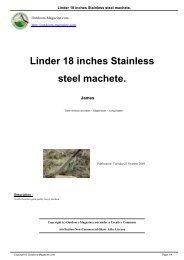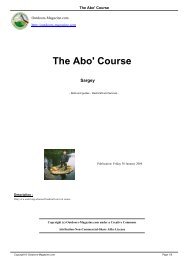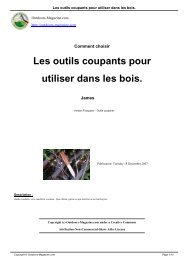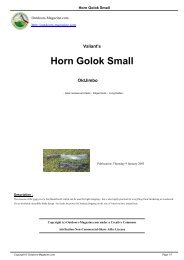Parang Lading and Klewang Sumbawa - Old Jimbo's Site
Parang Lading and Klewang Sumbawa - Old Jimbo's Site
Parang Lading and Klewang Sumbawa - Old Jimbo's Site
Create successful ePaper yourself
Turn your PDF publications into a flip-book with our unique Google optimized e-Paper software.
Description :<br />
Outdoors-Magazine.com<br />
http://outdoors-magazine.com<br />
<strong>Parang</strong> <strong>Lading</strong> <strong>and</strong> <strong>Klewang</strong> <strong>Sumbawa</strong><br />
<strong>Parang</strong> <strong>Lading</strong> <strong>and</strong> <strong>Klewang</strong><br />
<strong>Sumbawa</strong><br />
<strong>Old</strong>Jimbo<br />
- Gear reviews <strong>and</strong> tests - Edged tools - Long blades -<br />
Publication: Thursday 9 January 2003<br />
I can still remember opening the parcel which included the <strong>Parang</strong> <strong>Lading</strong>. While older people like me, often remember things from years ago better than things<br />
recent. I can remember so vividly because I get the same feeling every time I unsheath the blade!<br />
Copyright (c) Outdoors-Magazine.com under a Creative Commons<br />
Attribution-Non-Commercial-Share Alike License<br />
Copyright © Outdoors-Magazine.com Page 1/13
<strong>Parang</strong> <strong>Lading</strong> <strong>and</strong> <strong>Klewang</strong> <strong>Sumbawa</strong><br />
The <strong>Parang</strong> (knife) is a traditional knife of Malaysia <strong>and</strong> Indonesia.<br />
Probably one of the biggest surprises I've had was finding out that a lot of people who collect swords, never use<br />
them. In fact most swords wouldn't last long against trees. I can see that with swords designed for slashing, but it's<br />
hard to believe that people never get to try out their swords to see just what they can cut. Pity! Well only one of these<br />
blades could properly be called a sword - being primarily a fighting weapon - the <strong>Sumbawa</strong>. The parang is a tool for<br />
getting through dense mixed jungle. You'll sure tire of chopping before these two reach their limits! Just make sure<br />
you read the warnings first BEFORE GOING OUT TO DO SOME CHOPPING!!!!!!<br />
Firstly - I'm into experimenting with what can chop through mixed bush, <strong>and</strong> am not knowledgeable about weapons.<br />
For a real overview of Indonesian weapons go here:<br />
I can still remember opening the parcel which included the <strong>Parang</strong> <strong>Lading</strong>. While older people like me, often<br />
remember things from years ago better than things recent. I can remember so vividly because I get the same feeling<br />
every time I unsheath the blade! As you'll gather from my pages I'm rather a practical person, <strong>and</strong> not exactly into<br />
collecting - so seeing something like this came as quite a shock:<br />
This of course does it more justice - but the first picture was taken after cutting through things that I wouldn't have<br />
believed that any blade would have gone through!<br />
Copyright © Outdoors-Magazine.com Page 2/13
<strong>Parang</strong> <strong>Lading</strong> <strong>and</strong> <strong>Klewang</strong> <strong>Sumbawa</strong><br />
In actual fact, very little in the way of pictures is going to really describe one of these blades. It's like seeing a picture<br />
of some huge snake on television - quite different from having one sharing the couch with you. The damascus is<br />
somewhat different from what is usually made in the west, consisting of pamor.<br />
Here I quote what Jean-Marc (singularity) posted on the forums:<br />
"I asked about damascus blades <strong>and</strong> if they were for presentation or could be use, here is a part of the answer:<br />
In reply to:<br />
Our damascus blades are indeed using blades just like the good ol' days, NONE of them are for presentation or<br />
decoration purpose only (though some collectors might do). Every single blades are properly made (even to the<br />
"fanciest" ones) <strong>and</strong> treated with a very basic idea in mind ... someone's gonna use them somehow, someday!<br />
BTW, 90 out of 100 antique goloks are in damascus ... which Indonesian people refer to 'besi pamor' or 'balik mipih'.<br />
And as we clearly <strong>and</strong> proudly stated in our website, the people who forge <strong>and</strong> make our blades (especially the<br />
damascus ones) are STILL of the same generation who made the same style of blade 2-3 centuries ago! Yes, we did<br />
create some new hybrid or 'fancy' looking blades to cater the collectors, but more than 80% of them are based on<br />
original <strong>and</strong> traditional concept ... "form follows function".<br />
I also received the following on Valiant's blades damascus structure, thanks to Mr Suw<strong>and</strong>i:<br />
In reply to:<br />
Our damascus blades are different from the ones you probably have known where the patterns are parallel <strong>and</strong> laid<br />
alongside the core/hard metal in the middle. In this case, the impact on the blade is absorbed by the core only. You<br />
can always see layers of steel at the spine.<br />
Copyright © Outdoors-Magazine.com Page 3/13
<strong>Parang</strong> <strong>Lading</strong> <strong>and</strong> <strong>Klewang</strong> <strong>Sumbawa</strong><br />
please refer to PAMOR MLUMAH. Ours are totally of different concept where the patterns created because of the<br />
forging, no core, just layers of s<strong>and</strong>wiched steel. impact is absorbed by the whole blade (layers of soft <strong>and</strong> hard<br />
steel). You seldom see any layers of steel at the spine.<br />
Please refer to PAMOR MIRING.The negative factors (if there are some forging imperfections) are: - if the blade<br />
cracks, it will crack throughly to the other surface (you can see the other side through the crack) though it may not<br />
affect its performance at all; - if the soft steel unexpectedly becomes the outer layer of the cutting edge, it may be<br />
vulnerable.To show the difference, attached some references based on a keris structure which is quite different from<br />
our blades, but at least they would give you a better idea in what we're talking about."<br />
><br />
I then received this:<br />
Copyright © Outdoors-Magazine.com Page 4/13
<strong>Parang</strong> <strong>Lading</strong> <strong>and</strong> <strong>Klewang</strong> <strong>Sumbawa</strong><br />
What I really wanted to know is if the blades could chop through seasoned birch effectively, <strong>and</strong> still be in one piece<br />
<strong>and</strong> sharp. The simple answer is yes! For people who want to know why their blade is not only beautiful, but very<br />
strong, well now you know! In the real world out there in the bush, the blade will soon be black with sap, <strong>and</strong> you<br />
won't be able to tell what it's made from. Then you sit by a fire by some river, the wood having been hacked out of<br />
large driftwood by the blade, <strong>and</strong> get to cleaning it. It's like watching a photographic print develop, as the patterns in<br />
the blade start to show. Quite the experience! Normally I finish up the profiles on the blades with a belt grinder, <strong>and</strong><br />
Copyright © Outdoors-Magazine.com Page 5/13
<strong>Parang</strong> <strong>Lading</strong> <strong>and</strong> <strong>Klewang</strong> <strong>Sumbawa</strong><br />
they rarely really need retouchup in the field, but if you want the sharpening experience of all time, then honing one of<br />
these with a ceramic, while sitting by a river <strong>and</strong> fire is some experience too. The steel has quite a feeling to it as you<br />
hone away. I don't see any way of really describing this, that would make sense. Eventually of course, the etching<br />
gets polished down, <strong>and</strong> you only see the damascus show as it catches the light. I think that I'd advise people to<br />
practise with etching solutions first on a cheaper blade like the golok, to bring out the hamon line on it. With a little<br />
experience, it's not so hard to re-etch the damascus.<br />
Here's a close up of the end of my <strong>Sumbawa</strong> just after I got it.<br />
Steel <strong>and</strong> blade construction are only part of the picture, though. What surprised me about the parang is the comfort<br />
of the carved h<strong>and</strong>le <strong>and</strong> the balance. Nothing from pictures will come close to describing what one of these feels like<br />
in the h<strong>and</strong> - if you have some chopping experience...<br />
The Chopping <strong>and</strong> the Warnings...<br />
I'm quite aware that any adult can go into a store <strong>and</strong> buy the largest chainsaw there. Lots of us are still happily<br />
walking around with all of our parts despite this: some aren't. These blades could be far more dangerous than a<br />
chainsaw because they don't appear as dangerous. The <strong>Klewang</strong> <strong>Sumbawa</strong> is a straight edged blade <strong>and</strong> so is less<br />
capable of achieving the draw cut. It's also an extremely heavy blade for its type, <strong>and</strong> you have to be fairly strong to<br />
manage it. If it hits any part of you, then you have something that b<strong>and</strong>-aids are not going to fix. The parang is VERY<br />
likely to achieve a drawing cut, sail through stuff you think no blade could ever get through - without slowing - <strong>and</strong><br />
then you will have major problems if any body parts are in its path. The biggest problem with this blade is if it's the<br />
first one that you try chopping with. You'll make some trial chops <strong>and</strong> all will go well, <strong>and</strong> you'll think that you know its<br />
capability. When by accident, you find yourself making a drawing cut, you'll find that you had no idea of its capability!<br />
I started with a golok <strong>and</strong> from experience made sure that there was always a substantial stop (a log or tree) between<br />
the blade path <strong>and</strong> me. I learned the hard way that without such a stop I would have been injured. Now that I know<br />
what I think is the capability of the blade - I keep a stop that is a factor of three times that between me <strong>and</strong> the blade<br />
path. Where this is not possible, I'm very careful of deflections, <strong>and</strong> where I'm cutting. Simply put, the parang is very<br />
tip heavy, more liable to deflections that you will not be able to stop, <strong>and</strong> is capable of cuts that you will not believe<br />
even after you've made them. I realize that lots of people are using parangs in daily life - but they grew up with them!<br />
I would figure the $40 for a golok <strong>and</strong> time spent learning would beat walking around the rest of my life with a false<br />
leg if at all. These are not some sorry dreamed up blades of low capability, they are the real thing. If I use a parang to<br />
Copyright © Outdoors-Magazine.com Page 6/13
<strong>Parang</strong> <strong>Lading</strong> <strong>and</strong> <strong>Klewang</strong> <strong>Sumbawa</strong><br />
clear trail, I often wear chainsaw pants <strong>and</strong> protective gear.<br />
Having said all of that, of course I'm eventually going to be getting the parang Langgi Tinggang! I'm not telling people<br />
to avoid the blades, simply that like all deadly things they dem<strong>and</strong> some respect. Given my experience with the<br />
relatively light parang lading, I'd expect quite a learning curve with the heavier parang - <strong>and</strong> I'm quite strong! The<br />
advantage of the parang over other blades is that for a relatively light single h<strong>and</strong>ed blade - it's incredibly efficient.<br />
One might be able to clear trail with a machete, but when you come up against clumps of alder saplings it's slow<br />
going. The tip heavy parang clears everything in its path. The reason I carry one instead of a two h<strong>and</strong>ed brusher is<br />
that the latter doesn't do well on light springy vegetation, <strong>and</strong> is a two h<strong>and</strong>ed tool. I'm usually carrying a long<br />
h<strong>and</strong>led axe which I use as an additional guard by holding the head <strong>and</strong> planting the end of the h<strong>and</strong>le on the<br />
ground. It works well for me is all I can say.<br />
The <strong>Klewang</strong> <strong>Sumbawa</strong>:<br />
Copyright © Outdoors-Magazine.com Page 7/13
<strong>Parang</strong> <strong>Lading</strong> <strong>and</strong> <strong>Klewang</strong> <strong>Sumbawa</strong><br />
I chose the h<strong>and</strong>le design on the right wanting a slightly larger grip<br />
I got this one simply for its weight, so that I could see how a heavy golok would h<strong>and</strong>le. I also wanted to learn what<br />
effect having a straight blade would make. For sure I could have asked W<strong>and</strong>i, but I wanted to learn myself - <strong>and</strong> he<br />
was very anxious to make sure that I knew what I was getting since these were made up on special order <strong>and</strong> are<br />
much heavier than usual. While a straight blade of this length, weight profile can be used with drawing cuts, if you are<br />
not successful, then too much vibration comes back through the h<strong>and</strong>le. It's an incredible learning tool though, for<br />
someone who likes to use cutting tools, <strong>and</strong> of course I take it out all the time, even knowing that something else<br />
might work better... The only problem with blade forums is that people regularly come along who believe that their<br />
special blade will chop anything. Usually that blade is a straight edged design - like this one. By having what is<br />
probably the ultimate in straight edged cutters (<strong>and</strong> it is with the profile <strong>and</strong> length), I can stay grounded in reality. For<br />
sure this blade is capable of some staggering performance - but from what I know now, that would pale before<br />
something properly designed for wood <strong>and</strong> of the same weight <strong>and</strong> edge profile.<br />
Closeups of the <strong>Sumbawa</strong> h<strong>and</strong>le.<br />
Copyright © Outdoors-Magazine.com Page 8/13
[image]<br />
<strong>Parang</strong> <strong>Lading</strong> <strong>and</strong> <strong>Klewang</strong> <strong>Sumbawa</strong><br />
The h<strong>and</strong>le on the <strong>Parang</strong> <strong>Lading</strong> looks as if it could never be comfortable due to the carving. The big<br />
surprise is that it's remarkably comfortable <strong>and</strong> secure for me, <strong>and</strong> the carving contributes to this.<br />
Copyright © Outdoors-Magazine.com Page 9/13
<strong>Parang</strong> <strong>Lading</strong> <strong>and</strong> <strong>Klewang</strong> <strong>Sumbawa</strong><br />
Copyright © Outdoors-Magazine.com Page 10/13
[
<strong>Parang</strong> <strong>Lading</strong> <strong>and</strong> <strong>Klewang</strong> <strong>Sumbawa</strong><br />
most certainly weren't - W<strong>and</strong>i told me that he had a few of the heavy <strong>Sumbawa</strong> made up on special order - <strong>and</strong> that<br />
the traditional version was the shorter <strong>and</strong> lighter one. Whoever came up with the design weight <strong>and</strong> balance must<br />
have been someone like me - <strong>and</strong> I thought I was the only model! One of the "concerns" I had when ordering the<br />
blade was the amount of ornamentation at the end of the h<strong>and</strong>le. Like all of these blades though, it's traditional, <strong>and</strong><br />
serves a very definite purpose in actual use. When you hit a tree without the sabering cut, <strong>and</strong> get vibration, the<br />
h<strong>and</strong>le does seem to dampen it. It also provides a very secure grip which is equally important - especially since any<br />
proper cuts - even those which take down the tree in one swipe - often lead to a very loud cracking sound. You want<br />
a very secure grip when hearing that unexpectedly for the first time! It's as loud as when you (hopefully safely)<br />
springboard a small leaning tree, <strong>and</strong> it splits to the top.<br />
It does take a lot of strength to wield these blades, <strong>and</strong> one might want to do some practise with something safer<br />
than the blade itself.<br />
From Neal Stephenson's "Snowcrash" - a delight of a book for anyone into swords, science fiction - or both..<br />
"Hiro is in his 20-by-30 at the U-Stor-It. He is spending a little time in Reality, as per the suggestion of his partner.<br />
The door is open so that ocean breezes <strong>and</strong> jet exhaust can blow through. All the furniture — the futons, the<br />
cargo pallet, the experimental cinderblock furniture — has been pushed up against the walls. He is holding a<br />
one-meter-long piece of heavy rebar with tape wrapped around one end to make a h<strong>and</strong>le. The rebar approximates a<br />
katana, but it is very much heavier. He calls it the redneck katana."<br />
And yes I do know that a katana is used two h<strong>and</strong>ed.. But - that is the best illustration of how to get some practise.<br />
Using something that will only break your leg rather than remove it - might be a good method...<br />
As to why someone in a sci-fi book would have a sword:<br />
"The Deliverator never pulled that gun in anger, or in fear. He pulled it once in Gila Highl<strong>and</strong>s. Some punks in Gila<br />
Highl<strong>and</strong>s, a fancy Burbclave, wanted themselves a delivery, <strong>and</strong> they didn't want to pay for it. Thought they would<br />
impress the Deliverator with a baseball bat. The Deliverator took out his gun, centered its laser doohickey on that<br />
poised Louisville Slugger, fired it. The recoil was immense, as though the weapon had blown up in his h<strong>and</strong>. The<br />
middle third of the baseball bat turned into a column of burning sawdust accelerating in all directions like a bursting<br />
star. Punk ended up holding this bat h<strong>and</strong>le with milky smoke pouring out the end. Stupid look on his face. Didn't get<br />
nothing but trouble from the Deliverator.<br />
Since then the Deliverator has kept the gun in the glove compartment <strong>and</strong> relied, instead, on a matched set of<br />
samurai swords, which have always been his weapon of choice anyhow. The punks in Gila Highl<strong>and</strong>s weren't afraid<br />
of the gun, so the Deliverator was forced to use it. But swords need no demonstrations."<br />
Like fine blades, I find Neal Stephenson novels very thought provoking <strong>and</strong> enjoyable! It's strange to think that there<br />
really are sword carrying geeks around, <strong>and</strong> that I might be classified as one!<br />
Conclusions:<br />
Most of the large Valiant blades are made in both regular steel <strong>and</strong> damascus. So if you want to try the design of one<br />
of these traditional blades for a very good price, you are certainly able to do so. The regular steel blades are zone<br />
hardened, so with a little work you can bring out the hamon, <strong>and</strong> have a blade that will keep you intrigued for years.<br />
Copyright © Outdoors-Magazine.com Page 12/13
<strong>Parang</strong> <strong>Lading</strong> <strong>and</strong> <strong>Klewang</strong> <strong>Sumbawa</strong><br />
That's so even if you never use the blade for much chopping. With all the warnings on the page, you certainly don't<br />
need any more - so I'd just say that if you get one of the damascus blades, you'll likely soon have many more to<br />
enjoy <strong>and</strong> keep it company. That's so because this is a different construction of damascus <strong>and</strong> something very<br />
different from what most of us have seen. It's also of a price that means that you can go out <strong>and</strong> work with it, reprofile<br />
or sharpen it, re-etch it. What we have here are blades that are very different from most that we have experience<br />
with. Some of course won't like them at all, but others like me who believed that blades are just to be used, might find<br />
their beliefs changing with regards to the importance of looks of blades. I would suspect that those who prefer more<br />
modern looking blades might be requesting some grinding work on them after seeing the potential of a large convex<br />
edge profile.<br />
There are online articles on the Valiant site. I believe that a little research is needed to find the blade that best<br />
matches the intended purpose. Some blades are designed more for cutting masses of light material, some for<br />
chopping, <strong>and</strong> some of course are traditional designs for removing heads or fighting.<br />
Hopefully I've begun to provide a little insight, as well as given people something to keep them away from the<br />
television for a while. The fact is, though, that everything about these blades is complex - from their looks to their use.<br />
It would good to go to Jean-Marc's site to get more information, as well as see what is written on the forum posts.<br />
Jean-Marc's posts <strong>and</strong> his article on testing the blades against a banana tree should keep a person occupied for<br />
hours.<br />
I'm truly indebted to Jean-Marc for his encouragement to try these blades, <strong>and</strong> for his incredible perceptions on why<br />
they work so well <strong>and</strong> can mean so much to us!<br />
Please read this safety warning if you intend to use big blades.<br />
Post-scriptum :Original article at <strong>Old</strong><strong>Jimbo's</strong> site.<br />
Copyright © Outdoors-Magazine.com Page 13/13






